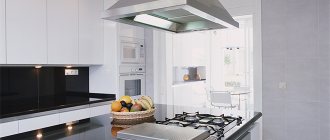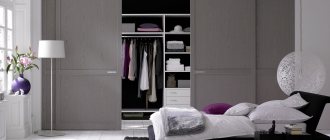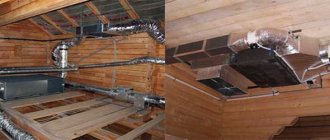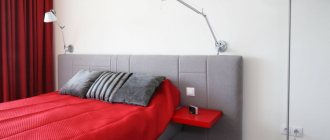It happens that in a building there is a “dead” room without windows. This situation can also be observed in apartments, for example, after redevelopment or on the first floors with access to a busy street (which is why they are covered with bricks). They are also made in private homes: these are boiler rooms, storerooms, garages, and basements.
Even more often, such rooms are found in non-residential buildings: in warehouses, in office premises, in shopping centers. Sometimes they are used as a dressing room or storage room. No matter how “unnecessary” such a room may seem, it is necessary to install a ventilation system in it.
Why is ventilation needed and its types?
In areas where clothes and shoes are stored, it is imperative to organize good air exchange. Skin particles remain on things and shoes, skin secretions remain, and dust accumulates. All this is an excellent environment for the development of microorganisms. Therefore, good ventilation in the dressing room is a prerequisite for maintaining the normal state of things and the absence of a musty smell.
In dressing rooms, as in any other rooms, ventilation can be natural or forced. Natural ventilation works through physical processes - cold air enters from below, heats up and rises to the top. Therefore, if you make a supply hole at the bottom and an exhaust hole at the top, air movement will be ensured at a certain speed.
The principle of organizing ventilation of a house or apartment. Wardrobe ventilation is part of this system
If there are ventilation ducts near the dressing room, it makes sense to make a branch to the exhaust vent. This will solve many problems.
But the natural ventilation of a dressing room cannot always provide a sufficient air exchange rate. To increase it, fans are installed. They can be installed in both supply and exhaust openings. Most often, a forced hood is installed, and air flows naturally through ventilation gaps or holes. This allows you to not spend too much money, but still ensure a normal atmosphere in the room.
What happens?
Ventilation for dressing rooms can be of various types. Let's look at some of them individually.
- Forced ventilation. This option is used when natural air circulation becomes insufficient. However, it is better to organize such a system already at the stage of designing a house. In this case, it will be necessary to bring a chimney from the common system. It will also be necessary to install a special fan of the required power.
- Doors with ventilation. Such products are doors equipped with special ventilation grilles. They can be of different sizes. The mesh itself can be installed from below and from above. These products allow you to control the level of humidity and temperature differences inside the room, provide good circulation of air flow, and also remove toxic components from the room. The ventilation holes themselves can be round, oval or square. Decorative rings are usually additionally attached to such structures. Doors often have not only aesthetic qualities, but also increase the level of sound insulation in the dressing room.
- Design with air intake system. This option is most suitable for dressing rooms that do not have window openings. In this case, several small horizontal holes are created at the border with the adjacent room where the system is already installed.
- Combined ventilation. This option is used when the dressing room is combined with the rest of the living spaces in the house. But in such rooms the system must be strong enough. Sometimes several powerful fans are used simultaneously, as well as several filtering devices. Sometimes special ventilation shafts are also used.
How to check whether a room without a window is ventilated?
Most often, in houses, especially apartment buildings, the developer provides a natural ventilation system. It is designed as follows: air exchange occurs through vertically located channels that run from the roof of the house to the basement. Using special outlets, unventilated areas of apartments are connected to the ventilation system. For many reasons, the ventilation in a room may not work.
In order to check the functionality of the ventilation system, you need to set fire to a rolled-up sheet of newspaper and bring it to the grille. It should be kept at a distance of 2 cm; if the paper is pressed against the grille, then the ventilation is working correctly and nothing interferes with the air circulation. If smoke goes into the room or the sheet is not pressed under the influence of the air flow, then there is no hood.
Tip: When checking how the system functions, do not use open flame. The newsprint should smoke but not burn. An open fire can be dangerous, as combustible and various flammable substances can form in a clogged exhaust pipe.
Kitchen hoods
The hood is an important element of ventilation in the kitchen. Today, the hood is a fashion accessory. It rids the kitchen atmosphere of moisture, unpleasant odors, gas and grease fumes.
Today, kitchen hoods perform not only practical, but also aesthetic functions.
Based on the principle of operation, there are two types of hoods:
- Active. They are connected to a common house ventilation shaft or lead directly to the street.
- Passive. Serves as a filter. They absorb air from the kitchen, clean it of impurities and release it back. They are not connected to ventilation.
Hoods vary in power. If the kitchen is large and food is prepared frequently and in large quantities, you need to purchase powerful equipment. The hood is powered by power. You can turn it on and off yourself and adjust the traction.
The role of air circulation systems
Ventilation in a room without windows plays a big role. Even if a room is used infrequently, carbon dioxide accumulates in it. If more than one person is constantly in the room, heat is generated at the rate of 60 W per hour, it creates excess moisture, which, in the absence of natural or artificial ventilation, will settle on the walls. As a result, it will be very stuffy inside, fungus will form on the walls, the spores of which are dangerous to breathe.
Clean ventilation ducts may not always provide the required amount of fresh airflow, even if the room has a window. The fact is that solid plastic products reliably insulate the room. There are positive aspects to this, but there are also disadvantages, for example, the room does not ventilate itself. With the help of special equipment, the problem can be solved: the system will forcefully ventilate the room.
Finish: ceiling
Proper finishing of the ceiling will make the room more comfortable and add height to it. A light coating will relieve the visitor of the oppressive feeling of a hanging ceiling.
It is permissible to use suspended ceilings and plasterboard structures to create multi-level lighting. This technique will help to visually lift the ceiling and smooth out the boundary between it and the wall.
Walls
Light paint or wallpaper is usually used to cover the walls. The wallpaper may have a small, discreet pattern.
The technique of one contrasting wall is often used, on which photo wallpaper, wallpaper of a contrasting color, or mirrors are placed.
You can use striped wallpaper. Moreover, horizontal stripes increase the width of the room, and vertical stripes increase the height.
Floor
It is preferable to use light brown flooring. Laminate or parquet can be laid diagonally, which will help visually expand the space.
Arrangement of forced ventilation
Knowing how to make ventilation in a room without windows or with solid structures, you can do the work yourself. To do this, you will need two fans with approximately the same power. In addition, you will need to purchase a heater and filter; One device will be enough to operate the system.
In order to have somewhere to get air from, ventilation channels are punched in the walls. Pipes will be inserted there: to make holes for them, you will need to use a hammer drill.
Air exchange requirements for rooms without windows
According to documents SP 60.13330.2012 and SP 54.13330.2016, for a residential space with an area of less than 20 m2, regardless of the number of people, the required air exchange is 3 m3/h per 1 m2 of area. Thus, full ventilation in a dressing room with an area of 8 m2 requires an air exchange of 24 m3/h.
For the bathroom, the standards are somewhat different. Regular air exchange should be 25 m3/h for separate and combined bathrooms and toilets.
If a closed room is a bedroom or other room in which people are constantly and the area of which is more than 20 m2, there must be at least 30 cubic meters of air per person per hour.
Ventilation in a windowless room in an apartment is possible using two methods:
- If the room has an external wall, then fresh air is supplied directly from the street.
- If not a single wall of the room faces the street, then the flow of air into the room without a window must be organized through another room with good ventilation.
Ventilation of a blind room without a window with an external wall
The easiest way to organize a flow of fresh air is with the help of supply devices - a wall valve or a breather.
Wall valves generally have low performance and are only suitable for small spaces. The breather organizes air supply for five people. Its three filters purify dirty air from dust, allergens and harmful gases. The Breezer is compatible with the MagicAir smart microclimate system, so it is convenient to control it from a smartphone.
The exhaust air will tend to another room where there is exhaust ventilation, for example, a bathroom.
Installation of a wall ventilation valve
Such a dressing room layout, where only one room is adjacent, will not allow connecting supply and exhaust ventilation. Currently, this problem can be solved by installing a power valve in the wall.
This device is a plastic pipe through which air from the street flows directly into the locker room.
It is worth remembering that installing a ventilation valve in the wall interferes with the architectural appearance of the building. However, this activity, like the installation of air conditioners, is currently not regulated by law.
The inlet valve consists of the following components:
- external ventilation grille, which prevents moisture, dirt, large solids and insects from entering the structure;
- a filter that cleans the outside air of small particles, directing the purified air into the locker rooms;
- a valve that allows you to continuously regulate the air flow in the room.
More expensive models have a noise reduction system, automatic humidity control, and a special design where air coming from the street through a valve enters the radiator, where it is heated to room temperature, and then enters the dressing room.
The installation of a wall vent must be carried out by a professional as the external part will be installed at a certain height. Work at height must be carried out in compliance with all safety requirements.
Don't want to hire a professional to install your wall valve? In this case, we recommend reading the installation instructions.
Ventilation in a blind room without an external wall
Leaving the door to the room open to allow fresh air from another room to enter is the simplest solution, but not always ideal. For example, if a windowless room serves as a workshop, you will need to lock the door to protect children and pets from fragile parts or dangerous tools. In such a situation, doors with bars at the bottom or ventilation holes in the wall will help.
If it is not possible to organize ventilation of each room, then the volume of air entering the ventilated rooms should be sufficient for the volume of all rooms.
When ventilation is organized during the process of redevelopment or repair, one of the walls of the room without windows is not completed, that is, 10–20 cm are left between the top point of the wall and the ceiling. The air movement to the hood will be directed through this hole.
If your home has a ventilation system, you can try running a separate line of ducts to the room. This option is more relevant for those premises in which finishing work is still underway; otherwise, laying additional air ducts in the ventilation system may ruin the repair.
Lighting
A bedroom without a window will only become cozy if there is proper artificial lighting. You can choose one of the following lamps, or create a multi-level system from different light sources:
- Chandelier. The smaller the room, the smaller the ceiling chandelier should be. Ideally, the product will have a built-in lighting power regulator.
- Spotlights. Sometimes they are used independently, but most often they are an addition to a chandelier. The products are convenient because you can build separate lighting for each zone and turn it on as needed.
- Desk lamp. This includes bedside lamps and desk lamps. In the work area, the lighting can be brighter, and on the bedside tables it can be calmer and dimmer.
- Decorative lighting. LED strip allows you to make the ceiling more expressive and soaring, or beautifully decorate the borders of the bed. Also often used are garlands on shelves and accessories, as well as light boxes, which are usually placed on the wall or ceiling. Such a box helps create an imitation of a window.
As for the temperature of the main lighting, it should be selected in accordance with the daylight outside - approximately 4500K. This effect is created by fluorescent lamps.
Bulbs with warm light can be placed in separate areas, which are more often used in the evening.
Ventilation in a blind bedroom without a window
Ventilation in a bedroom without a window requires a particularly careful approach: the air quality determines how easily you will wake up in the morning. In just an hour, two people in a bedroom manage to “inhale” a level of carbon dioxide that is three times higher than the norm! It is precisely because of the high concentration of CO2 that in the morning we are overcome by a feeling of weakness and lack of sleep.
In this case, natural ventilation in a room without windows is unlikely to provide the necessary air exchange - we recommend using a breather so that there is always enough fresh air. The CO2 sensor of the MagicAir monitoring system will help you track the level of carbon dioxide in the room.
How much air do you need to provide?
It is important to calculate the required volume of air masses required for the room. In calculations you need to rely on the following nuances:
- how many people and how often will be in such a room;
- what exactly will the room be used for (if for relaxation and quiet time, then you can get by with an influx of 30 m³/h per person, if complex physical work is performed, then 60);
- what conditions are typical for the room (for example, if it is a basement, then the likelihood of dampness inside is higher than in an above-ground room);
- whether harmful hazardous substances will be released (for example, if a workshop is being built in a windowless room where painting work will be carried out).
For most cases, a simple calculation can be done. It follows from this that about 30 cubic meters of air per hour are required per person in the room. This is the minimum value, but in general it is advisable to raise it to 32-35 cubic meters of air per hour.
Style selection
For a small room without a window, you can choose an interior in one of the following styles:
Minimalism
The simplicity and conciseness of the style involves strict lines, calm tones and a minimal amount of decor. All furniture is particularly functional, and all things in the room are in their place.
Bedroom without a window in a minimalist style Source dizainexpert.ru
High tech
Functional and high-tech interior. The space is filled with simple colors, glass and metal surfaces. The furniture is made in clear geometric lines. The decor is minimal and also distinguished by severity and conciseness.
Bedroom in high-tech style Source design-homes.ru
Eco style
The space of the room is decorated in natural colors. The combination of colors and materials is aimed at achieving a relaxing effect. There is nothing superfluous in nature, and the interior is quite minimalist, and each thing performs several functions at once.
Provence
A sophisticated interior in pastel colors, with a lot of decor, artificially aged furniture and many patterns. The atmosphere of the room invites you to relax comfortably and inspires you to do something new.
Bedroom in Provence style Source ciscoexpo.ru
Modern
The interior combines antiques and modern appliances and furniture. Quite muted colors are used, simple furniture without frills. The lines in the interior are smooth, and the surfaces do not have a pronounced texture.
Modern style bedroom Source roomester.ru
Japanese
This style is difficult to confuse with any other. The room contains only the necessary things, there is practically no decor. Natural materials are used to make furniture, and works of traditional art are selected as decorations.
Japanese style bedroom Source roomester.ru
How to make ventilation in a dressing room without windows
Mostly, dressing rooms are located in small rooms without windows. In this case, there is no hope for air flow through the cracks. We need to make holes. Inflow can be provided through:
- gap between the bottom edge of the door and the floor;
- special door design for dressing rooms (with slots or inserted ventilation grilles);
- holes in the walls, which are located at a height of no more than 20-30 cm from the floor (possibly lower, just above the baseboards);
- technological gaps left during the construction of partitions;
- in private houses - through a ventilation hole in the floor (from the lower floor or from the basement, if there is normal humidity there).
There are adjustable grilles
The dimensions of the supply openings depend on the volume of the room and the speed of movement of air masses. According to the standards in dressing rooms for storing things, it is necessary to ensure a one-time air exchange. For example, what if your dressing room has dimensions of 1.5 * 2.0 * 2.8 (width, length, height), then its volume (found by multiplying all numbers) is 8.4 cubic meters. In an hour, to maintain normal air, 8.4 cubic meters of air. This way, dressing room ventilation will prevent the appearance of foreign odors.
If ventilation works normally in the apartment, for these purposes it is enough to make an inlet opening measuring 100*100 mm. Section - round, square, rectangular - it doesn't matter. The main thing is that its area remains the same or more. In general, this parameter is calculated or found from a table. But the tables indicate much larger volumes.
Table of dependence of air exchange on the size of ventilation ducts and exchange rate
But the ventilation of the dressing room will work normally provided that there is an exhaust duct. This could be a similar lattice in the wall. It should be located on the wall opposite the supply hole, closer to the ceiling. Moreover, we must strive to space these holes as far as possible - so that the air flow covers as large an area as possible.
If the supply opening is made in the door, and the doors are in the middle of the width of the room, then it is worth installing two exhaust grilles - on the right and on the left, 15-25 cm away from the corners.
Where should the exhaust vents go? At best - into the ventilation duct. A possible option is to go outside, if one or more walls of the dressing room face the street. In this case, you can take the supply duct to the street, and the exhaust duct to the ventilation or any of the adjacent rooms.
Is a fan needed?
As has already been said, the natural ventilation of the dressing room does not always provide sufficient air movement speed and a musty smell still appears. This usually happens in the summer, when it is too hot outside and natural air movement is minimal or the draft generally reverses (air masses move in the opposite direction). In such cases, fans are installed on the exhaust openings. Their power is selected depending on the volume, but as a rule, the lowest power ones are sufficient - 10-50 cubic meters per hour. In this case, the main selection criterion is quiet operation. After all, many dressing rooms open onto bedrooms or other living spaces.
Fans may vary. You can even use computer coolers
Many people find it intimidating to install fans—they have to run almost 24/7. In general, not necessarily. It is quite enough if it turns on for 15-20-30 minutes every hour. This mode is provided by timers, controllers and other similar devices. All that is required is to select the operating mode and set the appropriate settings.
Yes, this is an additional expense, but the forced ventilation of the dressing room works constantly and does not depend on the vagaries of the weather.
How to do it?
In many ways, the solution to this problem depends on whether this room borders the street or not. If it borders, then it will be much easier to install a ventilation system, and this will not require the installation of air ducts. If it does not border, then the task becomes more complicated, and will depend on how far the room is from the street.
Another main rule: in “dirty” rooms an exhaust hood is always installed, and in “clean” rooms a supply air supply is installed. “Dirty” includes the kitchen, bathrooms, and rooms where harmful substances are released into the air.
Below we will look at some of the simplest situations and methods for solving them.
If it's a kitchen
A prerequisite for organizing a ventilation system is the presence of a ventilation shaft in it. It will act as an exhaust system and stale air will be removed through it. The second option is to exhaust air through a kitchen hood (which is vented either into the ventilation shaft or directly outside, through a wall or through an air duct).
The air flow will be carried out from other rooms: either through the cracks under the doors, or through the transfer grilles (if there are no cracks).
In this case, it is necessary to check the draft of the ventilation shaft. To do this, you need to take a strip of thin paper and bring it to the ventilation grill.
If the piece of paper is attracted, the ventilation shaft is working normally. If not, or attracts very weakly, the ventilation shaft either does not work at all or works poorly (possibly due to the fact that it is clogged and needs to be cleaned). If for some reason cleaning is not possible now, it makes sense to install a forced exhaust fan in the wall, with output directly to the street.
The power of the fan must completely ensure the removal of air in a volume equal to the number of people living, multiplied by 30. For example, if 3 people live in an apartment, then the fan must remove at least 90 cubic meters of air per hour.
If this is a room that borders the street through at least 1 wall
If this is a “dirty” room, then a hole is made in the street wall and a fan is inserted into it. It will draw air out, and the influx will come from other rooms (through transfer grilles or through cracks under the doors).
Arrangement of fresh air ventilation in the apartment
If this is a “clean” room, then an inflow is made through the street wall using any of the methods below:
- through the supply wall valve;
- through the air handling unit;
- through the hole with the installed fan.
Air removal will be carried out through another room from which the hood is made.
If this is a room that does not border the street
Often in such cases we are talking about a storage room (if it is an apartment or a house), which is often located in the “depths” of the home.
In this case, you can arrange the ventilation system in one of the following ways:
- If a room without windows is located between another room where there is an inflow, and another room in which there is an exhaust hood. You can make holes in the walls between them by covering them with bars (or installing a fan in one or both holes). This option is suitable if you need little air (if the room is small), and if clean air will come from the room from which there will be inflow.
- If the building (apartment, house) has an air duct system (either supply or exhaust, or one or the other). In this case, a separate line of air ducts is laid to a room without windows. If the ventilation duct serves only one purpose (for example, it only removes air), then the inflow also needs to be arranged separately. This can be done, for example, from the next room, through a hole.
- If the room is too large, or the exhaust/ventilation shaft opening is far away, it would be better to lay an air duct for both supply and exhaust. Moreover, in this case it is necessary to install a fan on both systems.
Installation of ventilation in a room without windows (video)
If the room is located below ground level
We are talking about the basement. If at least a small part of the room is above ground level, an inflow can be made through the wall in this place. The exhaust is done through the building's exhaust system (ventilation shaft or simply an exhaust hood). If there is no ventilation shaft, then air is removed through a hole (with or without a fan) in the wall, which is opposite the inflow point.
If the room is located completely below ground level, in this case both supply and exhaust are organized through air ducts with fans. Pipes are laid from the surface, through the walls, opposite each other (supply on one wall, exhaust on the other). Fans are inserted into the pipes: one supplies air inside, the second blows it outside.
In a room located below ground level
Many basements have a section that is located above ground level, usually reserved for the stairs. This place can be equipped with an artificial air flow system mounted into the wall.
To eliminate air stagnation, simply connect to a ventilation shaft or exhaust ducts. You can also create another hole in the wall with a fan, opposite the point through which the inflow will occur.
When the entire room is located below ground level, the only option left is to use ductwork with a fan. To do this, it is necessary to lay pipes going out to the first floor, securing them to the walls.
One will be responsible for the inflow, the other, located on the opposite wall, will be responsible for the outflow. A fan is installed in each of the pipes, which will direct air in the appropriate direction, depending on the purpose of the pipe (inflow or outlet).
Natural ventilation in a dark room
If the layout of the apartment was initially designed in such a way that there are rooms without windows, then the walls must have ventilation ducts for natural ventilation, which look like small holes in the wall under the ceiling, covered with bars.
If there are no such holes in the wall or the draft is disrupted, then the air in the room becomes stuffy. Natural ventilation in such rooms can be easily improved by installing a fan on the air duct opening or by installing special forced-type air supply devices if there are no air ducts in the wall.
The movement of air masses can also be improved by cross-ventilating the entire apartment. But through ventilation during the cold period is fraught with the formation of condensation on windows and walls.
No. 7. Magic of the mirror
The mirror surface can be used not only to create false windows. Everyone knows how a simple mirror can transform the interior of a small room. It doubles the space and light - just what you need for small rooms without windows.
You can choose a large solid mirror panel, make a composition from small mirrors, or lay out an entire wall or part of it with mirror tiles - there are plenty of options for every taste and interior style. Do not forget that part of the furniture facades can be mirrored. An interesting effect is achieved when decorating the upper part of the walls with a mirror . In a similar way, you can simulate the windows described above.
Do-it-yourself supply ventilation in a dead room
Sometimes the natural ventilation of an apartment is not enough to ensure normal air exchange in all rooms, especially where there are no windows. Therefore, for a normal microclimate in rooms without windows, forced ventilation is used.
In a room without windows, forced-air ventilation is most often installed.
The supply ventilation system consists of a hole in the wall and a valve with a plug. Sometimes the supply ventilation in the bedroom is additionally equipped with fans, heaters and filters for air purification.
Most people do not know how to make ventilation in a room without windows with their own hands, but installing ventilation does not require special knowledge or effort. To organize ventilation you will need:
- A device for making large-diameter holes in a wall or a hammer drill with a special attachment.
- A piece of plastic pipe of suitable diameter.
- Plug and mesh.
- Insulation.
A hole is made in the wall into which insulation is placed. A piece of plastic pipe of suitable diameter is inserted into the hole on top of the insulation. The voids between the insulation and the pipe are filled with polyurethane foam.
On the street side, the pipe is covered with a mesh to prevent street debris from entering the valve. In the room, the hole is closed with a specialized plug with the ability to regulate the air flow.
In a room without windows, this type of ventilation helps to provide a comfortable microclimate, but in winter it will require additional costs to heat the room.
If the owner wants to save on heating the room in winter, he should purchase a ready-made structure that allows the room to be ventilated at any time of the year without additional energy costs. Such ready-made structures can also be installed independently.
No. 11. Light colors
The ability to reflect light varies among different colors . For example, dark, saturated shades absorb a significant portion of the radiation, while light shades, on the contrary, mostly reflect it. White works best in this regard , which is why designers fell in love with it, actively using it in all small rooms. It is better to choose it for the ceiling. If it doesn’t quite fit into your interior plans, then choose another light shade. It is important that the ceiling is lighter than the walls.
unobtrusive light and pastel shades of for walls and furniture . Beige, cream, light blue and light peach will make the room cozy, create a feeling of open space and much-desired natural light. Do not forget about shiny finishing materials: metallic wallpaper, glossy plaster, etc.
To prevent the interior of the room from being completely boring, it can be complemented with several bright accessories. Natural shades are preferred. Two or three bright colors will be enough - otherwise you can overload the room.
Ready-made solutions for your home
To simplify the ventilation of rooms without windows, forced ventilation devices were invented. Such devices are called aerogivers; they are easily mounted on a wall inside a room. Although air vents are expensive and can only provide fresh air in the room where they are installed, they are an excellent ready-made solution for organizing air exchange.
A good ready-made solution for apartments and houses with blind rooms is split systems with climate control.
Aerogivers
Aerogivers consist of devices that allow the flow of clean air into the room; filters to clean the air from dust, harmful impurities, and allergens; recuperators and dryers.
It is easy to install the airgiver in an apartment yourself; to do this, you will need to carefully study the instructions and prepare the device for making a hole in the wall.
The main advantage of such devices: the room is ventilated around the clock, but there are no unpleasant odors from the street in the room. Clean air enters the room already heated, because... Most of these devices are equipped with a recuperator.
When installed correctly, aerogivers do not create additional noise in the room, so they can be installed even in a nursery.
Air conditioner
Almost all modern air conditioners are made in such a way that they provide a flow of fresh air into the apartment from the street, and do not simply dehumidify the air inside the room. Therefore, split systems with climate control are a complete replacement for natural ventilation in rooms without windows.
Some air conditioners can additionally enrich the air with ions, warm it up and clean it of allergens.
But split systems with climate control capabilities are installed point-by-point and are not able to ensure the correct movement of air masses throughout the apartment. Therefore, to ensure a comfortable microclimate throughout the apartment, it will be necessary to install air conditioners in each room.
Ventilation devices
Ventilation can also be achieved using special devices. They are divided into groups depending on the direction of air movement inside. In practice, the following classification is most often used:
- Inlet.
- Exhaust.
The installation specification directly depends on the type chosen. Additionally, system requirements and characteristics should be taken into account. For example, a ventilation valve is installed directly into the wall itself. That is why the layout of the building and diversion routes is of key importance here.
Wall ventilators help eliminate unpleasant odors in office premises. They are also installed in the kitchen, toilet or bathroom. If necessary, the flow of fresh air can be organized in rooms of another type.
Ventilators for PVC windows
Window ventilators also help organize the necessary circulation of air masses. The most common installation method is a hole in a window opening or a special grille in plastic windows. In practice, another classification of all devices used is also used:
- Depending on the specification of the method of air penetration into the room: mechanical or natural.
- The service space plays an important role: local or general purpose.
Modern supply and exhaust systems help organize the flow of fresh air at any time of the year through the use of purifiers and filters. At the same time, they do not have a negative impact on the temperature in the room, since they use recuperators. Their choice is also preferred by institutions.
Schemes of ventilation systems for dressing rooms of different layouts
In addition to volume, the main parameter when choosing a scheme is the layout and location of the wardrobe in the apartment. Further actions depend on where exactly it is located and what rooms it borders on.
The options are:
- A wardrobe (essentially a partition from floor to ceiling that delimits a room).
- Separate room with window.
- A separate room without a window, through the wall (at least one) - the street.
- A separate room, surrounded by other rooms (no window or outside wall). The option is the most inconvenient in terms of ventilation, but the most common - in apartment buildings, utility rooms are usually planned this way.
Below we will look at how to make a ventilation system for each case.
Closet
This option is common in both apartments and houses - instead of installing ordinary wardrobes and/or chests of drawers.
The air exchange device depends on how many walls (partitions) the wardrobe has and what size it is. Typically, such wardrobes are not made huge: most often it is a “simple” wardrobe with shelves and drawers, just not free-standing, but “attached” to the wall.
Let's consider how to organize its ventilation depending on different layouts:
- If the closet has only one - front - partition, and on the other 3 sides there are apartment walls bordering the living rooms. It will be enough to embed the transfer grilles in the lower and upper parts of the partition.
- If the closet has only a front partition, the remaining 3 sides have apartment walls, one of which borders the bathroom/kitchen. In this case, you can embed a transfer grille into the lower part of the partition (through it there will be an air flow from the room to the closet). To remove air, you can drill a hole in the wall between the cabinet and the kitchen/bathroom and cover it with a grill. The option is not the most convenient: perhaps in the future you will want to rearrange and move the cabinet, and in this place there will be a hole in the wall.
- If the cabinet has 2 or more partitions. In this case, a flow grille is embedded from below into the partition, which is located closer to the window. The second transfer grille cuts into the top (closer to the ceiling) in the partition, which is located closer to the door.
In general, it is not necessary to bother with ventilation in wardrobes - in most cases, it is enough to simply cut the flow grilles into the door, and that will be enough.
Separate room with window
The simplest option, in which you can do nothing at all: all the conditions have already been created.
Dressing room with 2 windows
In this case, air flow can be ensured in the following ways:
- Keep the window slightly open. Suitable if the window sash is fixed in several positions, and if there is no source of loud noise or odors under your window.
- Install the window comb and keep the window slightly open. Suitable if the window sash does not have “its own” fixation modes. Cost: the simplest comb can cost up to 1000 rubles.
- Install windows with micro-ventilation mode (if the apartment is under renovation, or it’s time to change the windows). This option is better than the previous ones in that you don’t have to keep the window open. This means that street sounds and smells will not enter it, insects will not fly in, rain or snow will not fall into it.
- Install the window valve. Suitable if it is not possible to keep the window open (for example, due to noise), and it does not have a ventilation mode. The downside is that not everyone can install the valve with their own hands. The product itself will cost about 3-5 thousand (depending on the model), installation by specialists can cost about the same.
- Install a window fan. If your dressing room is large, or some expensive items will be stored there, then this option can be considered. Natural ventilation (all the methods above refer to it) has unstable performance, while a fan can maintain constant air exchange.
For the flow and further removal of air, there must be a gap under the door to the wardrobe. If it is not there, then you can embed a transfer grille (or a valve, like Domvent) into the door leaf.
A more expensive and somewhat unusual option: you can install a miniature Aeromat installation in the window. Inside the rectangular housing there are fans that supply air to both the supply and exhaust. That is, they can renew the air even in a sealed room. The downside is that such products cost several tens of thousands of rubles, and only a specialist can install them.
Separate room without window, street through the wall
It will be more difficult to independently organize a ventilation system in such a room than if there was a window. But there are many implementation options.
An example of a ventilation system for such a layout: 1 - air flow through the gap under the door; 2 - place for inserting an exhaust fan
In the previous paragraph, we considered a scheme in which air only enters the dressing room from the street - since in a room with a window this option is the simplest. If there is no window, then in any case you will have to make a hole in the wall for ventilation. And through it it is already possible to organize both inflow and exhaust.
First, let's look at how the air flow through the wall is done. To do this, a hole is drilled in it and a wall valve is inserted. The option is the simplest and cheapest (the valve itself can be purchased for 3-5 thousand, installation will cost the same amount).
There is another option, but it is impractical: instead of a valve, an air supply unit is installed. This device is more expensive: such equipment will cost more than 10 thousand rubles. The most important thing: the units have high air output - which is not necessary for a small dressing room.
As mentioned above, instead of an influx from the wardrobe, you can organize an exhaust hood. In this case, a hole is drilled in the wall and an exhaust fan is inserted into it (which will not blow into the room, but into the street). This option is suitable if the room with a dressing room is located far from the kitchen/bathroom.
The general rule for any method: there must be a flow of air between the wardrobe and the corridor (or room). To do this, either there must be a gap under the door, or there must be a transfer grille in the door leaf.
Separate room, surrounded by other rooms
The most inconvenient and difficult option to implement. Such layouts are common: owners often make wardrobes in closets, which are located “inside” the apartments. And when building houses with dressing rooms, they are also usually located exactly according to this plan.
An example of a ventilation system for such a layout (laying air ducts from the dressing room to the ventilation shaft in the bathroom)
In this case, it will be more difficult to complete the task, especially on your own (without specialists). There are several solution schemes:
- In the wall that borders the living room with a window, if the room is further from the kitchen/bathroom than the wardrobe, a hole is made and covered with a grill. Air will flow through it. The air is removed through the gap under the door into the corridor and then to the nearest ventilation shaft or exhaust hood. If there is no gap, a transfer grille is installed in the door.
- If there is a kitchen/bathroom or a room with a hood across the wall with the wardrobe, a hole is made in this wall and covered with a grill. Air will be removed through it. Fresh - will enter through the gap under the door/transfer grille.
- If the house/apartment is under renovation and suspended ceilings will be installed, you can install a system of air ducts that will remove air from each room. In this case, a separate line is drawn to the wardrobe. The influx of fresh air will come through the gap under the door. The exhaust line can go either to the nearest ventilation shaft (as in the image above), or through the wall to the street (in this case, an exhaust fan is placed in the air duct).
Sources
- https://stroychik.ru/garderobnaja/osveshhenie-i-ventilyaciya
- https://sdelalremont.ru/sposoby-ustrojstva-ventilyacii-v-komnate-bez-okon.html
- https://tion.ru/ventilyaciya/v-komnate-bez-okon/
- https://climatdoma.net/ventilyatsiya-dlya/nezhilyh/ventilyaciya-v-komnate-bez-okon.html
- https://vozduhstroy.ru/ventilyaciya/v-komnate-bez-okon.html
- https://ventihome.ru/dlya/nezhilyh/ventilyaciya-v-garderobnoy-komnate.html
[collapse]
To ensure silence
When installing regular grilles on both opposite walls in the locker room, noise will penetrate through them. Clothes and space will dampen them a little, but some sounds will be heard. If you don't mind this prospect, then that's okay. But if you want silence, you can install special grilles or valves in the openings.
They barely block air flow, but they block light and noise. These grilles aren't cheap, but there's no other way to ensure that cabinet ventilation is efficient and sound-proof.











